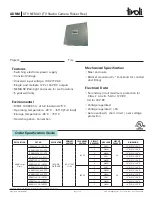
4
HOW THE LINKS1000 WORKS
Cellular Communications
All cellular telephones, including the LINKS1000, must ‘register’ with the cellular network. ‘Registration’ is simply a
handshake, sending ESN and Telephone number, between the cellular switching station and the cellular telephone.
This is done upon power up of the LINKS1000 and randomly once a day. If the phone does not register the network
will not complete a call. Tower signal strength, also called RSSI (receive signal strength indication) is updated
approximately every 4-5 seconds. RSSI is indicated as a go/no go visible via the RSSI LEDs (L3, L4, L5, L6).
Sending an alarm
Before dialing the central station, all DSC alarm controls perform a telephone ‘line-test’. This is done via the
control unit using a series of off-hook and on-hook transitions to verify dial-tone. This takes 30 seconds.
The control panel ‘line-test’ feature will only determine a telephone line is inoperative when it is attempting to
send an alarm. With a LINKS1000 connected, the control panel will send the central station telephone number,
in a digital format, from the PGM output of the control panel to the PGMIn input of the LINKS1000. The
LINKS1000 then accesses the cellular telephone network and begins dialing. Once a suitable channel is
established the LINKS1000 switches an onboard relay and establishes a connection between the TIP and
RING terminals on the control panel and the T1 and R1 terminals on the LINKS1000.
With cellular communications now open to the central station receiver, the panel will detect ‘handshake’. The
alarm is sent. If the message is received, ‘kiss-off’ is sent, just as if it were communicating over a standard
telephone line. Once the panel has completed the transmission, the control panel ‘hangs up’. The LINKS1000
then detects the loss of current across T1 and R1 and sends the END key to the cellular network.
Telephone Line Monitor
The Telephone Line Monitor is a separate feature integral to DSC or Sur-gard control panels. The TLM looks
for a 30 second loss of telco line voltage. With a LINKS1000 connected and TLM signaling enabled, a service
outage would trigger the panel to begin dialing though the LINKS1000. Dialing will begin after the TLM time-
out and ‘line-test’ are complete. This should take 1 minute.
Trouble supervision
By default the trouble supervision jumper J1 is OFF (removed) and there are three separate trouble outputs:
AC trouble (AC TBL), Battery trouble (BAT TBL) and System trouble (SYS TBL).”
The AC TBL terminal and Bat TBL terminals are each used to indicate their respective troubles. The LINKS1000
SYS TBL will activate for all other troubles. These outputs are connected from the LINKS1000 terminals to
separate zones on the control panel. The zone(s) connected to the BAT TBL and SYS TBL should be
programmed as LINKS Supervisory. The zone(s) connected to the AC TBL should be programmed as AC
Trouble. Under normal conditions, the TBL outputs of the LINKS1000 are “open”. When one or more of the
six monitored trouble conditions are present, and the corresponding time-out has expired, the respective
output will be pulled to ground. The connection from the LINKS1000 TBL output to the control panel zone,
forces the zone to ground. The panel now has a trouble it must send and the dialing sequence begins.
Typically, trouble signals are sent via the telco line. If the telephone line is not operational, the panel will send
the signal via the LINKS1000 and the cellular network.
This configuration is required on UL Listed systems.
Emergency Phone Number
This number is programmed into the LINKS1000 and will be dialed when the AUX IN terminal is shorted to ground.
To program the number, enter the emergency phone number into the LINKS1000, exactly as it would be dialed
on a cellular phone. To use this feature, place an ordinary handset in parallel with the panel on the LINKS1000
T-1, R-1 terminals and connect a normally open push-button across the AUX IN and Ground terminals.
NOTE: This input is a 24-hour, silent terminal and the Panic phone call will be connected through
the cellular network.







































